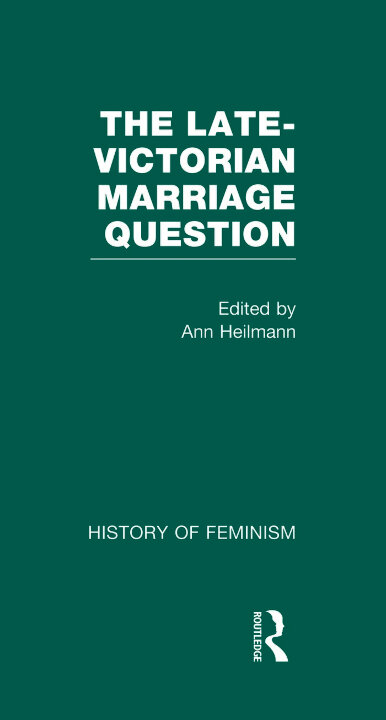Access to the full content is only available to members of institutions that have purchased access. If you belong to such an institution, please log in or find out more about how to order.
Loading content
We were unable to load the content

The Late-Victorian Marriage Question A Collection of Key New Woman Texts
- Edited by
- Ann Heilmann
- Published: 1998
- DOI: 10.4324/9780415179430
- Set ISBN: 9780415179430
This anthology contextualizes key feminist texts and ideas by linking them with the transformation of public opinion brought about by the late Victorian debate on marriage, motherhood and women's right to an independent life.
Included are Mona Caird's controversial The Morality of Marriage; debates between feminists, traditionalists and anti-feminists on marriage, divorce and the New Woman, and selected reading from New Woman fiction, both feminist and anti-feminist, which reproduces the media debate on morality in literature.
Set Contents
‘The close of the nineteenth century marks an epoch of social revolutions’, the Humanitarian stated in 1896, awarding the New Woman pride of place in its list of latter-day developments: she was ‘the first in importance, the most abounding in potentialities and in common interest’. At a time of social, cultural and political upheaval, the New Woman epitomized the anxieties but also the hopes of the fin de siècle. Her sexual anarchy accentuated contemporary fears about the shifting categories of gender and sexuality, while her growing cultural resonance enhanced concerns about the feminization of literature and the impending death of virile Englishness. Her political demands reflected the crisis of the old order riven by class conflict at home and colonial unrest abroad, yet with her call for the restitution of moral standards and her celebration of women’s nurturing qualities she saw herself as an agent of the ‘regeneration and purification’ of the nation. A vibrant metaphor of transition, the New Woman became a symbol both of the dissolution of society, and of that society’s moral renovation.
This volume places the controversy on marriage and motherhood in the context of the New Woman debate. While the three debates were linked, each had its own dynamic and saw shifting alliances and antagonisms. Most interestingly perhaps, both female conservatives and male progressives (who were not necessarily feminist in outlook, and were often distinctly hostile to feminism) were influenced by feminist thought, and drew on New Woman discourses to argue their own causes. All three camps deployed eugenicist arguments: traditionalist women and progressive men to postulate the duty of female self-sacrifice in marriage and motherhood, feminists to advocate women’s right to ‘purify’ domestic and political life.
New Woman fiction left its mark on fin-de-siècle British culture, transforming the literary landscape well beyond the turn of the century; it also had a considerable impact on the formation of popular as well as political thought. ‘[T]hanks to our efforts’, Sarah Grand wrote in 1896, ‘the “novel with a purpose” and the “sex novel” are more powerful at the present time, especially for good, than any other social influence.’ By organizing their fiction around the primary concerns of the Victorian women’s movement (marriage, motherhood and moral reform; gender roles, sexuality and personal development; education and the professions; political emancipation), feminist writers created a gynocentric genre at the intersection of cultural politics and political activism, within whose framework feminist ideas could be articulated, theorized and popularized for a predominantly female mass market.
The Story of an African Farm (1883) heralded the advent of New Woman fiction eleven years before the New Woman was named. An immediate bestseller, the book made Olive Schreiner famous overnight, publicizing feminist ideas to a diverse readership, with one working-class woman saying that ‘I think there is hundreds of women what feels like that but can’t speak it, but she could speak what we feel’. Constituting the most spectacular case, in Victorian writing at least, of female teenage rebellion stifled by anorexia nervosa, its heroine Lyndall enabled Schreiner to introduce into narrative literature many of the feminist themes which, a decade later, would come to represent New Woman fiction generally.
This volume brings together the voices of female New Woman writers and late Victorian literary criticism. The contemporary debate on New Woman fiction formed part of a wider discourse on decadence, degeneration and the crises of gender and sexuality in culture, literature and political life. Many female New Woman writers, though constructed as decadents by the press, saw themselves as a regenerative force in society, and therefore as the opposite of fin-de-siècle decadence, which they regarded as a predominantly male and masculinist movement indifferent or hostile to the woman’s cause.